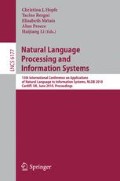Abstract
While qualitative relations (e.g. RCC8 relations) can readily be derived from spatial databases, a more difficult matter is the representation of vague spatial relations such as ‘near-to’,‘next-to’, ‘between’, etc. After surveying earlier approaches, this paper proposes a method that is tractable, learnable and directly suitable for use in natural language interfaces to spatial databases. The approach is based on definite logic programs with contexts represented as first class objects and supervaluation over a set of threshold parameters. Given an initial hand-built program with open threshold parameters, a polynomial-time algorithm finds a setting of threshold parameters that are consistent with a training corpus of vague descriptions of scenes. The results of this algorithm may then be compiled into view definitions which are accessed in real-time by natural language interfaces employing normal, non-exotic query answering mechanisms.
Access this chapter
Tax calculation will be finalised at checkout
Purchases are for personal use only
Preview
Unable to display preview. Download preview PDF.
References
Shekhar, S., Chawla, S.: Spatial Databases: A Tour. Prentice-Hall, Englewood Cliffs (2003)
Guttman, A.: R-trees: A dynamic index structure for spatial searching. In: SIGMOD 1984, June 18-21, pp. 47–57. ACM Press, New York (1984)
Hellerstein, J., Naughton, J., Pfeffer, A.: Generalized search trees for database systems. In: VLDB, pp. 562–573 (1995)
Dilo, A., de By, R.A., Stein, A.: A system of types and operators for handling vague spatial objects. International Journal of Geographical Information Science 21(4), 397–426 (2007)
Altman, D.: Fuzzy set theoretic approaches for handling imprecision in spatial analysis. Journal of Geographical Information System IBM 8(3), 271–289 (1994)
Wang, F.: Handling grammatical errors, ambiguity and impreciseness in GIS natural language queries. Transactions in GIS 7(1), 103–121 (2003)
Roy, A.J., Stell, J.G.: Spatial relations between indeterminate regions. Int. J. Approx. Reasoning 27(3), 205–234 (2001)
Randell, D., Cui, Z., Cohn, A.: A spatial logic based on regions and connection. In: KR, pp. 165–176 (1992)
Cohn, A.G., Gotts, N.M.: Representing spatial vagueness: A mereological approach. In: KR, pp. 230–241 (1996)
Fine, K.: Vagueness, truth and logic. Synthèse 30, 263–300 (1975)
Goyal, N., Shoham, Y.: Reasoning precisely with vague concepts. In: AAAI, pp. 426–431 (1993)
Santos, P., Bennett, B., Sakellariou, G.: Supervaluation semantics for an inland water feature ontology. In: IJCAI, pp. 564–569 (2005)
Pulman, S.: Formal and computational semantics: a case study. In: Proceedings of the Seventh International Workshop on Computational Semantics: IWCS-7, Tilburg, The Netherlands, pp. 181–196 (2007)
Bennett, B., Mallenby, D., Third, A.: An ontology for grounding vague geographic terms. In: FOIS, pp. 280–293 (2008)
Bennett, B.: A theory of vague adjectives grounded in relevant observables. In: KR, pp. 36–45 (2006)
Mador-Haim, S., Winter, Y., Braun, A.: Controlled language for geographical information system queries. In: Proceedings of Inference in Computational Semantics (2006)
Weidenbach, C., Brahm, U., Hillenbrand, T., Keen, E., Theobalt, C., Topić, D.: SPASS version 2.0. In: 18th International Conference on Automated Deduction, Kopenhagen, Denmark, pp. 275–279 (2002)
Minock, M.: C-phrase: A system for building robust natural language interfaces to databases. Data and Knowledge Engineering 69(3), 290–302 (2010)
Pinker, S.: The Stuff of Thought. Penguin (2007)
Author information
Authors and Affiliations
Editor information
Editors and Affiliations
Rights and permissions
Copyright information
© 2010 Springer-Verlag Berlin Heidelberg
About this paper
Cite this paper
Minock, M.J. (2010). Vague Relations in Spatial Databases. In: Hopfe, C.J., Rezgui, Y., Métais, E., Preece, A., Li, H. (eds) Natural Language Processing and Information Systems. NLDB 2010. Lecture Notes in Computer Science, vol 6177. Springer, Berlin, Heidelberg. https://doi.org/10.1007/978-3-642-13881-2_18
Download citation
DOI: https://doi.org/10.1007/978-3-642-13881-2_18
Publisher Name: Springer, Berlin, Heidelberg
Print ISBN: 978-3-642-13880-5
Online ISBN: 978-3-642-13881-2
eBook Packages: Computer ScienceComputer Science (R0)

